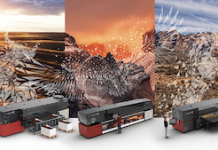Digital signage consists of a display unit — this might be LED, LCD, plasma or any similar technology — and it is strategically placed for marketing purposes. Digital signage varies in shape and size; it can be as small as a tablet or as big as a billboard. Units can display static images, video or be interactive.
A lot has changed in the past few years, with digital signage now more accessible and less complicated to use than before. Now, you no longer have to pay expensive annual support fees to receive so ware updates in addition to set-up costs.
Advantages:
1. Makes time fly: nobody likes to wait in line; long lines are one of the reasons customers leave stores. Some customers may return later, but others choose to go to the competition if it saves them waiting time.
To improve the customer’s experience, you can entertain them so they get the feeling that the waiting time is less. You can do this by adding a digital screen so people in queues have something to watch and keep them entertained, and therefore, in line. When adding a digital screen, customers perceive a decrease of 35% in wait time.
Millward Brown conducted a study on behalf of Impax Media, a developer of digital point-of-sale advertising networks, during a recent store trial. The study found the following: ‘69% of customers surveyed said they were either extremely or somewhat frustrated with long checkout lines. This answer received the most responses, with pricing too high and out of stock being the next two, coming in at 66% and 65% respectively.’
‘Interestingly, digital signage at grocery stores reduced the perceived wait time by more than a third (35%). And 84% of customers said that watching content on the displays helped the time spent waiting in the checkout line pass more quickly.’
2. Live content: unlike printed signage that is sta c and not easily changeable, digital signage provides the advantage of being more exible. Since it is connected to the internet, the content you display can be fed live, such as social media feeds, giveaway results, blog posts, weather, stock market updates, etc.
3. Customised content depending on the me or day: since ads on digital displays are dynamic, you can choose to show different and more appropriate things depending of the time of the day or the day of the week. Perhaps showcase items you use for work during the weekday and leisure items during the weekend, or a breakfast menu in the morning and brunch later on. So customers get to see what they need at the right time and will help you increase sales.
4. Quick, dynamic and contextual updates: digital signage is easy to update and control, some services allow you to upload or store your graphics and update them as often as you like. For example, during holiday season, you might be advertising a flash sale, but once it is finished you can replace this ad with a new one. Or if you are advertising an item but it becomes out of stock, there is no need for it to be advertised anymore, and you can remove this also; which helps you control time-sensiitive advertising. Another advantage of this is that if you have displays in various locations, you can choose to update them all at once, like a new product launch. It is beneficial to create a consistent look throughout the campaign.

5. Make automatic changes: it is really helpful when you have certain ads that need to be displayed during the same time everyday, or same day of the month. You can preprogramme these using a ruled-based software. Companies’ displays are connected through a network that makes it possible to decide which displays show specific content and change them all at once without having to make these changes manually.
6. Interactivity: with this feature you can use data-driven marketing to interact with customers and learn more about them. Possibly, you can offer additonal discounts in checkout line screens to customers who sign up with email.
7. More attractive: digital signage is not limited to static images; it can reproduce video, which generates 400% more views than a static sign, according to a three-month study by Intel on digital signage technology. Video attracts passersby and entices them to enter a business that they wouldn’t have visited if it weren’t for that.
8. Greater recall and retention: video produces more engagement than still images. It has a hypnotising power that holds people’s attention, which results in higher recall rates than motionless images. A more engaging viewer experience can be achieved by using simple anima ons and pause or zoom effects. Unexpected direction changes can be used to trigger specific responses. Using movement in certain ways will influence people to move toward it or to solicit specific responses.
9. Increase impulse purchases: digital signage showcases important messages, in-store specials, promotions and all sorts of permanent advertising inside stores. If a customer is still deciding on whether or not to make a purchase, this kind of advertising gives the the extra push to make the purchase.
David Bawarsky, an authority in the tech community said, ‘19% of people admitted to making an unplanned purchase because of digital signage. When you compound these unplanned purchases with digital signage’s effect on purchase amount, it’s easy to see how much of a boon digital signage can be to business’.
10. Extends customer’s stay time: digital signage leads to more in-store traffic and increases the time customers spend inside the store. A report from DataTrend found that digital signage increases purchase amount and dwell time by almost 30% each in retail business.
11. Quick and easy marketing feedback: most digital signage offers analytics so ware so you can monitor your marketing efforts and can direct your marketing strategy accordingly. Some of the things you can monitor are: timmes when store traffic is higher, which products are the most searched for, time people stay watching a store a video and eye movement to determine which part of the video attracts more attention.
12. Cost-effective: relevant ads can be run as and when needed. You can also have additional revenue after installing digital signage by selling advertising space to businesses that complement your own.
13. Lower operating costs: the administration is performed digitally and can be done by a single person in a central location. This person can manage all the updates consistently with brand standards across franchises and comply with changing regulations.
14. Reduced waste: after the promotion or campaign is over, there is no paper waste and extra purchases for the next one.
There are many advantages and benefits for digital signage and you might start to consider using this type of signage if you don’t already. eMarketer projected digital OOH advertising spending to reach $4.5 billion in 2019, up from $2.7 billion in 2014, in the United States alone. It is a medium that is destined to grow but will not necessarily replace printed signage, but rather complement it.
Submit your news and video content to journo@practicalpublishing.co.za
Subscribe to our YouTube channel, read the top 5 stories weekly on WhatsApp or sign up to our newsletter.
FLAAR REPORTS/DPI INSIGHTS www.flaar-reports.org















